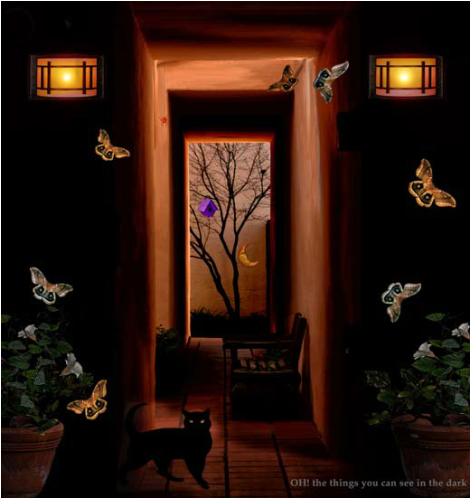Nocturnal Moths
In the darkness of night, moths take flight seeking flowers
that only open in the light of the moon.
Did you know that moths and butterflies are from the same family? What do you think they have in common? What makes them different?
that only open in the light of the moon.
Did you know that moths and butterflies are from the same family? What do you think they have in common? What makes them different?
The moon’s light is one of the ways nocturnal moths are able to navigate the night - a reference point that helps a moth determine where it is and where it is going. Nocturnal moths are phototrophic; they are light seekers. Light helps guide their way and can also indicate a food source, dictate sleep, or warn of danger.
Light also can be a source of confusion for these night travelers. Why moths flutter around a porch light or dance mad circles around a flame is still a curiosity. These lights offer no food, safety or guidance, yet moths seem drawn to them. Some speculate that because these lights are closer and much brighter than the moon's light, they are distracting. The moths become disoriented and confused; instead of following the straight path of the moon, they seem to lose their way. Others suggest moths may mistake bright lights for sunshine; thinking it is daytime, they seek a place to hide and end up going to sleep.
Night-blooming flowers are often white and reflect light, alerting moths to a source of nectar. Perhaps the brightness of fires and man-made light excites the moths into thinking they have found a giant midnight buffet? We may never know the exact reason why. However, using yellow lights outdoors, a color moths do not respond to, can help keep the moths on their night time journey.
Light also can be a source of confusion for these night travelers. Why moths flutter around a porch light or dance mad circles around a flame is still a curiosity. These lights offer no food, safety or guidance, yet moths seem drawn to them. Some speculate that because these lights are closer and much brighter than the moon's light, they are distracting. The moths become disoriented and confused; instead of following the straight path of the moon, they seem to lose their way. Others suggest moths may mistake bright lights for sunshine; thinking it is daytime, they seek a place to hide and end up going to sleep.
Night-blooming flowers are often white and reflect light, alerting moths to a source of nectar. Perhaps the brightness of fires and man-made light excites the moths into thinking they have found a giant midnight buffet? We may never know the exact reason why. However, using yellow lights outdoors, a color moths do not respond to, can help keep the moths on their night time journey.



